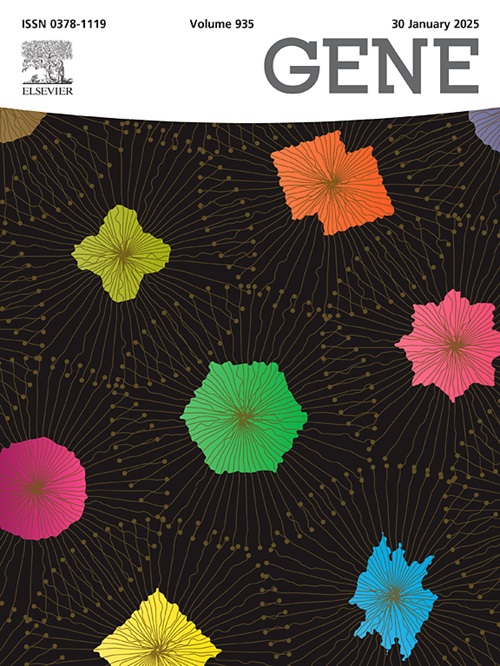Divergent adaptation to highland and tropical environments in Bolivian Creole cattle
IF 2.6
3区 生物学
Q2 GENETICS & HEREDITY
引用次数: 0
Abstract
Bolivian Creole cattle populations evolved under low levels of breeding management and, during more than 500 years of natural selection, became adapted to various environments such as the contrasting highland and subtropical environments. Recently, highland Creole cattle were crossbred with Holstein to improve dairy production. The aim of this research was to evaluate the divergent adaptation through selection footprints of Bolivian Creole cattle from Andean highland and tropical lowlands, and to evaluate the effect of Holstein introgression in highland Creole. For this purpose, 130 Creole cattle (75 highland, 55 lowland) and 88 Holstein were genotyped using a microarray. The database was used to determine population structure and admixture and detect selection sweeps using FST, Rsb, XP-EHH, and ROH. Ancestry inference suggested that selection peaks were not due to Holstein introgression. The NCBI database was used to retrieve genes from the common regions and then perform gene ontology analysis. The most prominent selection peaks were on BTA20 and BTA23 and included the PRLR (slick phenotype) and Class I and IIa BoLA genes. Other windows contained candidate genes for hypoxia (ANXA2, NDUFA4L2), angiogenesis and haematological parameters (ANXA2, CPLANE1, NRP1, NRP2), immune response (IL7R, IL6ST, IL31RA, C6, C7, STAT6, NKG2A, IRAK4, KLR, CLEC), oxidative stress (GSTA, HSD17B6) and morphological traits (PLAG1, CHCHD7, CAP2, ARL15). GO analysis revealed enrichment terms and pathways related to immune response, glutathione and retinol metabolism and reported QTLs for coat characteristics, immune response and tick resistance. The results suggest the complex mechanism in the adaptation of Bolivian Creole cattle to the contrasting highland and subtropical environments.
玻利维亚克里奥尔牛对高原和热带环境的不同适应。
玻利维亚克里奥尔牛种群在低水平的饲养管理下进化,在 500 多年的自然选择过程中,适应了各种环境,如高原和亚热带环境的对比。最近,克里奥尔高原牛与荷斯坦牛杂交,以提高乳制品产量。本研究的目的是评估玻利维亚克里奥尔牛通过安第斯高地和热带低地的选择足迹所产生的不同适应性,并评估荷斯坦引种对高地克里奥尔牛的影响。为此,使用微阵列对 130 头克里奥尔牛(75 头高地牛和 55 头低地牛)和 88 头荷斯坦牛进行了基因分型。该数据库用于确定种群结构和混杂情况,并利用 FST、Rsb、XP-EHH 和 ROH 检测选择扫描。祖先推断表明,选择峰并不是荷斯坦引入造成的。利用 NCBI 数据库从共同区域检索基因,然后进行基因本体分析。最突出的选择峰出现在 BTA20 和 BTA23 上,包括 PRLR(光滑表型)以及 I 类和 IIa BoLA 基因。其他窗口包括缺氧(ANXA2、NDUFA4L2)、血管生成和血液参数(ANXA2、CPLANE1、NRP1、NRP2)、免疫反应(IL7R、IL6ST、IL31RA、C6、C7、STAT6、NKG2A、IRAK4、KLR、CLEC)、氧化应激(GSTA、HSD17B6)和形态特征(PLAG1、CHCHD7、CAP2、ARL15)。GO 分析揭示了与免疫应答、谷胱甘肽和视黄醇代谢相关的富集项和通路,并报告了皮毛特征、免疫应答和抗蜱性的 QTLs。研究结果表明,玻利维亚克里奥尔牛适应高原和亚热带环境的机制十分复杂。
本文章由计算机程序翻译,如有差异,请以英文原文为准。
求助全文
约1分钟内获得全文
求助全文
来源期刊

Gene
生物-遗传学
CiteScore
6.10
自引率
2.90%
发文量
718
审稿时长
42 days
期刊介绍:
Gene publishes papers that focus on the regulation, expression, function and evolution of genes in all biological contexts, including all prokaryotic and eukaryotic organisms, as well as viruses.
 求助内容:
求助内容: 应助结果提醒方式:
应助结果提醒方式:


